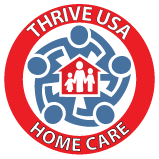3 Small Changes to Make Your Senior Loved One’s Home Safer
No matter the reason, a lot of elderly individuals insist on staying in their homes rather than moving to an assisted living facility. This is never an easy decision for a family to make, but allowing your loved one to stay in her house doesn’t have to be as worrisome or stressful as you may think. By preparing an “aging-in-place” environment, your loved one can remain in her home while minimizing the hazards. Here are 3 small changes you can implement to make your loved one’s home safer.
Minimize the Risk of Tripping
Accidental falls are statistically some of the most frequent causes of injury for people over 65. The good news is there are plenty of simple ways to greatly reduce this risk, beginning with eliminating the little things that cause tripping in the first place.
A lot of accidents occur around an entryway, so start improving that area first. Remove any welcome mats or throw rugs; even the tiniest bit of an accidental bunch-up can cause someone to trip and fall. Replace them with non-slip strips instead. If your entryway involves steps, install a no-rise ramp for easier access. If installing a ramp isn’t possible, make sure that the steps have handrails on both sides.
Throughout the home, apply non-slip wax to any hard flooring. If possible, laying down carpeting over hard floors would be the absolute safest option.
Increase the amount of lighting throughout the house. A lot of tripping accidents happen simply due to the inability to see a hazard. Motion-sensor lights are great for this, as they allow for everyone to see ramps, stairs, and corners without having to remember to turn them on.
Dealing with Stairs
A lot of houses have staircases leading to and from either a second floor or a basement. Unfortunately, stairs can sometimes be seen as the opposite of age-proofing a home. Arthritis, poor vision, exhaustion, and any number of ailments or diseases can make a trip down the stairs into a hazard.
If the house doesn’t have an upstairs or a downstairs, it immediately becomes much easier to make safer for your loved ones. If it does have a staircase, however, there are a few steps you can take to make them safer.
The obvious solution is to install a stair lift. These eliminate a majority of dangers associated with climbing stairs by safely elevating your loved one from top to bottom in a slow, near-effortless manner.
Unfortunately, stair lifts aren’t always an option for many families due to their high cost. If this is the case, there are ways to age-proof staircases. Start by adding non-slip threads to every step, minimizing the risk of slipping forward. To make them even safer, use multicolored treads so your loved one will be able to tell each individual step apart. Also make sure that there are handrails on either side of the staircase. Two handrails make it much easier for your loved one to steady his weight and keep his balance as he climbs or descends.
Of course, the safest option is to not use the stairs at all. Move the bedroom to the main floor, as well as everything used on a daily basis. The less time he spends on the stairs, the safer he’ll be.
Proofing Bathrooms
When creating an aging-in-place home, you should spend a majority of the time working to make the bathroom as safe as possible. Between the wet surfaces, exposed electrical outlets, various places to sit, and possible exposure to hot water, bathrooms can be littered with hazards if you’re not careful.
Replacing your loved one’s standing shower with a sit-down, easy-access bathtub is a very good place to start. Easy-access bathtubs are made for elderly individuals, equipped with handrails, a raised seat, non-slip mats, and easy-to-use faucets.
As with the case of stair lifts, however, installing easy-access bathtubs can be out of a family’s price range. If so, standing showers are still the most hazardous means of bathing for elderly individuals. If you cannot possibly replace this, make sure handrails are installed and non-slip mats are placed down both inside and outside of the shower. Removable shower seats also are a great option to turn a standing shower stall into something a little safer.
Bending down to sit on a toilet can also cause accidental falling. Purchasing a raised toilet seat not only eases any joint pain caused by bending down that low, but also makes it much easier for your loved one to do his business without much risk of falling over.
Exceptional In-Home Care in Central Maryland
These are just a few of the simple changes that could be made to your loved one’s home to make it safer for aging-in-place. If you want to ask for more advice, or want to make sure that your home is already safe for your loved one, contact the professionals at Thrive USA. It’s our goal to help your loved ones remain independent and safe for years to come!


